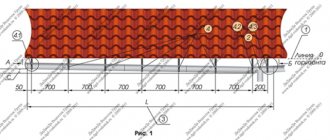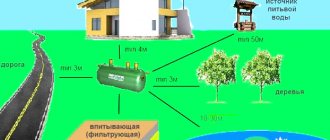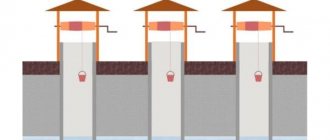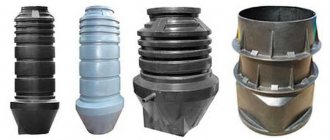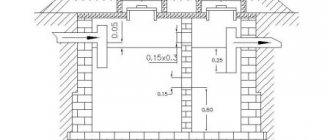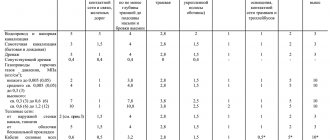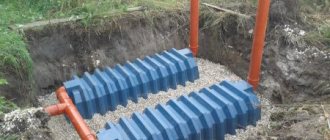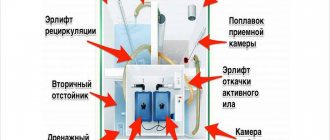The distance from the septic tank to the well can be determined independently according to SNiP. Moreover, you cannot break the rules, because if these structures are too close, there is a risk of wastewater spreading and entering the water supply system. This will lead to contamination of drinking water, which in turn is the most common cause of poisoning.
When choosing a location for arranging a hydraulic structure and septic tank, the size of the site and the type of soil are taken into account.
Rules for the location of the septic tank.
What documents regulate the installation of septic tanks
A septic tank is a device used to dispose of sewage, which causes a lot of trouble. We are talking mainly about the harm that wastewater brings to the environment, especially if their disposal is approached formally. It is important to minimize the risk of sewage entering a well or open ground. You cannot install a septic tank in a place you like; the installation project must be drawn up in advance and approved by the sanitary service. When compiling it, you must carefully study the provisions of the following regulations:
- SanPin 2.2.1/2.1.1.1200-03 is a document approved by the decree of the chief sanitary doctor back in 2007. Among other things, issues of sanitary protection of water supply sources are considered.
- SanPin 2.2.1/2.1.1.1200-03, which provides for the creation of sanitary zones near objects on the condition of which the level of environmental safety depends.
- SNiP 2.04.03-85 is a section whose drafters considered the feasibility of coordinating a local sewerage project with water supply projects.
- SanPin 2.1.5.980-00 – requirements for groundwater protection.
- SNiP 30-02-97, norms and rules related to the planning and development of country and garden partnerships.
- Federal Law No. 52, which regulates sanitary and epidemiological issues and ensures the safety of the population living near “dangerous” objects.
When developing sanitary and construction standards, experts performed calculations that made it possible to determine the distance of the well to the septic tank, the distance from the artesian well and other hydraulic structures that provide water supply. The experts also took into account the distance of the recycler from residential buildings and utility rooms. You should also not forget about fruit trees and the safety of neighbors, who should not be disturbed by third-party odors that can be emitted by a septic tank installed in violation of the rules. It is difficult to understand the intricacies of this piquant issue, and in this case it is better to seek help from specialists who will easily draw up a diagram of the location of the septic tank on the site.
Selecting the distance from the well to the septic tank
Selecting the distance from the well to the septic tank.
The recommendations remain the same as in the case of a well. Only wells are open structures, which increases the risk of runoff entering the water.
The most suitable option is 200 m. However, it is not possible to implement such conditions in modern realities, when in most cases the size of a summer cottage plot is 6 acres. For this reason, it is better to consider the possibility of constructing a well or choose another option.
Where to place a septic tank relative to a well or well on small land areas
When there is no way out and the task is to ensure water supply to the facility on the site through a local hydraulic structure, measures are taken to improve its protection from the penetration of wastewater:
- it is possible to move some objects, due to which it is not possible to place a well on the site along with a septic tank;
- waterproofing is carried out on the soil side: its structure changes, density increases due to the use of clay;
- you can use a biofilter instead of a cesspool;
- The productivity of the septic tank decreases or a small-volume structure is initially purchased.
Distance of the septic tank to the neighboring plot
When designing a wastewater disposal system, it is important to take into account all factors that can affect the efficiency of the septic tank. The efficiency of a septic tank is influenced by the terrain; to select the correct device, it is necessary to take into account the composition of the soil, the level of groundwater and the freezing depth, which is different for each region. Many people believe that a guarantee of safety is the maximum distance of the septic tank from water intake systems, gardens, orchards and residential premises, but in this case this rule does not work, and here’s why:
- In most cases, we are talking about suburban areas, the area of which does not allow installing the waste disposal unit at the recommended distance from the objects.
- Often we have to deal with problem areas that have characteristic terrain features with slopes and elevations. On a site with a slope, a guarantee of safety is to install the VOC at the lowest point of the site.
- If the groundwater level is high, problems may arise if a treatment station is installed above the aquifer, which can lead to its contamination.
Even at the septic tank design stage, you should not forget that there are other areas in the neighborhood, and therefore you will have to take into account the interests of your neighbors. Therefore, according to existing standards, the septic tank must be located at a distance of 5 meters from the neighbors’ individual housing construction. To avoid disease and death of animals, the distance to the neighboring outbuilding used to keep them should not be less than 4 meters. The distance from the local system to the plants, depending on their height, is 1-4 meters.
As for the distance to the neighbor’s fence, this is a controversial issue, and even experts cannot always give the correct answer to it. It is believed that the septic tank should be located at a distance of 2 meters from the fence, but this only applies if there are no residential, outbuildings, water intake or other communications behind the fence. In this case, the calculation of distances to the wastewater treatment plant is carried out not from the fence, but from the objects themselves.
Selecting the distance from the well to the septic tank
If the size of the plot allows, it is better to equip a hydraulic structure at a distance of 30-50 m from the septic tank. In this case, the point of liquid intake exceeds the groundwater level. The recommended distance to the nearest water source may vary slightly up or down.
The need for a significant removal of the hydraulic structure is due to the fact that the design of the septic tank is not always airtight (we are not talking about reliable plastic products). Leaks form between the concrete rings, and the metal rusts over time. In most cases, wastewater penetrates into the ground in minimal quantities, and from there into the well.
Location of septic tank and well on the site
Having resolved the issue with your neighbors, you will also have to think about your own safety, especially if the site is equipped with an artesian well that provides a supply of drinking water. It is important to create a sanitary zone, which will protect the source in the event of a pipe rupture or depressurization, in order to prevent sewage from entering the water intake. To do this, the septic tank is installed at a distance from the water supply source:
- 20 m if the site is on clay soil;
- 35 m if the septic tank is installed on loam;
- 50 m on sand and sandy loam.
It is easy to notice that in this case we are talking about long distances, which means that it is not possible to install a septic tank on every site, since the area for this may not be enough. In this case, experts do not recommend violating legal requirements; it is better to abandon the idea of installing VOCs, giving preference to another option for resolving the issue of wastewater disposal. In this regard, we would like to give useful advice - in order to organize the correct location of the septic tank on the site, order a professional analysis of the soil composition.
Drinking water is supplied to living quarters and outbuildings through a pipeline system, and wastewater is also discharged through pipes. Therefore, it is important to ensure the required distance between sewer and water pipes. According to the provisions of SNiP SNiP 2.07.01-89, there must be at least 40 cm between them, and they must intersect at an angle of 90°, while the supply pipe must be 40 cm higher than the outlet pipe. In the case of using polymer pipes, additional use of protective covers is assumed .
Sewer and water pipes. Laying rules.
Initially, when determining where the septic tank will be located on the site, in addition to all measurements, it is better to take into account the terrain, since the ideal location of the septic tank is lower in slope than the well.
The next important point is the laying and installation of pipes from the well to the house and from the house to the septic tank. To calculate the installation location, it is also necessary to comply with building regulations. The distance between the water pipe running from the well to the sewer pipe should be above 10 meters.
Such standards are considered so that if the sewer suddenly breaks, the drains do not contaminate the water coming from the well to the house.
Other requirements for the location of the septic tank
In most cases, problems with neighbors do not arise, but do not forget about those around you. Unpleasant odors of sewage often cause a lot of unpleasant moments for passers-by, especially if the waste disposal unit is forced to be installed near the sidewalk and roadway; moreover, many areas are located near water bodies, the pollution of which is already a global problem. Therefore, it is worth considering other sanitary standards for the correct location of the septic tank on the site:
- the sanitary zone in front of the reservoir covers a distance of 30 meters;
- the minimum distance to a stream or river is 10 meters;
- if the waste disposal facility is located on the side of the roadway, the septic tank can be located at a distance of more than 5 meters from the road;
- The septic tank must be located in front of the gas pipe at a distance of 5 meters or more.
Many owners of individual housing construction located on a small plot of land, unfortunately, are faced with the problem of lack of space quite often, but in some cases the problem can be solved at the design stage. In this case, it is enough to place the septic tank for a private house on the diagram so that it is on the side opposite to the location of the source of drinking water. If this is not possible, measures can be taken to waterproof the soil using clay and some waterproofing materials.
The sanitary and epidemiological requirements for the wastewater treatment device will be lower if a waste disposal unit of lower capacity is used. If none of the proposed methods is able to correct the situation, experts recommend replacing the septic tank with its analogue - a biological filter. It cleans faster, and devices of this class work much more efficiently. Accordingly, the distance to objects adjacent to the waste disposal facility is reduced significantly.
How many meters should be from the septic tank to the well?
There are several proven ways to make the 50 m distance required by sanitary standards much smaller without attracting regulatory authorities. On small areas of individual housing construction and construction projects, it is simply impossible to withstand the required removal.
Well in the village
Violation of the rules regulating at what distance to build a septic tank from the well may result in administrative penalties, monetary fines and even criminal liability according to the Code of Administrative Offences. The following recommendations should be taken into account:
- It is necessary to plan the necessary facilities in advance. You should also not rely on the opinion of builders. They may know the distance standards according to SNiP and installation rules, but sometimes the minimum distance between the septic tank and the source of drinking water depends on the type of septic tank. We should not forget that some types of installations may not comply with sanitary standards or require official permission due to the specific design. However, even the most stringent rules and regulations can be circumvented by maintaining specified distances and using the latest models of treatment or disposal of biological waste.
- It is not difficult to make the distance from the septic tank to the residential building the required 5 m from the foundation of the house, and this is a reasonable condition to protect the residential building from erosion of the soil and structure due to excess water or depressurization of the structure. But this condition can be easily circumvented if you use local cleaning systems, and not a “birdhouse” that is moved from place to place, or a model where the cesspool device cannot provide complete reliability. After all, even the construction of septic tanks made of concrete rings does not guarantee the absence of breakdown if the installation is carried out incorrectly or measures are not taken to strengthen the soil. This kind of trouble can also occur when a septic tank is used by more people than the volume norm was calculated, or the necessary studies were not carried out on the soil, and the construction was done without taking into account its type.
- A distance of 5 meters is considered sufficient to avoid an unpleasant odor or a long walk from the house. But the document establishing the standards does not say anything about the impossibility of placing a septic tank of the recommended type in the house. Septic tank Topas, dry closet, powder closet - all this is not a cheap pleasure, but they can be located at any distance from the place of water intake. They do not require special permission; they do not require a sewage disposal truck or travel for it. A well and other systems for obtaining water can be placed literally nearby, without fear of feces and secretions penetrating into the soil.
Diagram of distances from the septic tank according to SNiP and SanPiN standards
You can bypass the distance to the water pipe (and in the minimum version it is the same 5 meters) if you use high-quality cast iron pipes, and not the usual and cheap polymer option.
The nuances of placing a septic tank and well
The correct relative position (a cesspool below in relation to the well plus the installation of special filters, and the water intake at an elevation) allows you to set a distance of 30 meters, although according to other standards it should be at least 50. The main thing is to install a factory treatment station, and not rely on homemade and not always high-quality device.
Standard distances from the septic tank for SNT and individual housing construction
The distance from the septic tank to the filter well is a problem that arises when a developer wants to build a system that allows for constant mechanized water intake. The construction of a well and other devices does not encounter any particular difficulty on the part of builders.
Why choose septic tanks
Many enterprises and organizations are engaged in the sale, installation and maintenance of wastewater treatment plants in Moscow and the Moscow region, but the devices of Septic Topas Plus deserve special attention. We comply with all sanitary standards for the location of the septic tank on the site, we offer a wide range of septic tanks from well-known Russian manufacturers - Topas, Unilos Astra, Eurolos, Termit, Tver, Diamant, Ergobox, Dochista, Terra, Biozon and Kolovesi.
All devices are certified, and product quality is confirmed by a three-year warranty. In addition, we offer others to earn money, since the company has developed a number of profitable offers for partners. All work is carried out on a turnkey basis, and the staff consists of only trained specialists with extensive practical experience.
Distance from the septic tank to a residential building
Most experts and experienced builders choose a distance between the septic tank and a residential building of at least 5 m. The calculation is made from the foundation part of the structure.
Equipment can be placed at a shorter distance from home. However, in this case, it is necessary to choose a high-quality cleaning system that can provide guarantees that there are no unpleasant odors in the interior of the building.
Excessively remote installation of devices is also impractical. This circumstance is due to the unreasonably greater load on the pipeline, since the complexity of its operation is directly dependent on the length of the structure. In addition, such systems are more susceptible to blockages.
On a plot in the village
SNiP - permissible distances
There are a number of regulatory documents with precise instructions for the installation of septic equipment. For example, the following documents are used as guidance:
- 85—2.04.01;
- 84–2.04.02.
The documents list the following figures and norms for those who decide this issue:
- If aeration units are installed with a complete oxidation function, when processing waste up to 700 thousand liters per day, you must maintain a distance of 50 meters from the septic tank.
- When the productivity is 300 thousand liters per day, you need to keep in mind 150 meters when installing biological treatment structures. Often these models can dry out the sediment that has formed at the bottom of the sludge platform.
- 110 meters is the distance standard for biofiltration equipment, with a daily capacity of up to 50 m³.
- 5 meters – for any septic products.
- 8 meters is the distance to the septic tank from a well with a filter function.
- As for trenches, sand and gravel filters, their distance depends on productivity. 25 meters – 15 thousand liters per day, 20 meters – 8 thousand liters, 4000 liters – 15 meters, 10 meters – 2 thousand liters. Finally, for a thousand liters, 8 meters of distance to the septic tank is enough.
- 15 meters must be taken into account when operating filter fields, which pass up to 150 thousand liters per day.
back to menu ↑
